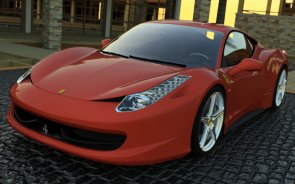NVIDIA GF100 Architecture and Feature Preview
To show off the increased compute performance of GF100, NVIDIA also ran a fully interactive GPU-based ray tracing demo during our briefing at CES. The ray tracing demo used two identical systems, one equipped with a GF100 prototype board and the other a GeForce GTX 285. And the actual ray tracing demo used an image-based lighting paint shader, ray traced shadows, reflections and refractions running at a resolution of 2560x1600. Frame rates at that high of a resolution were quite low--less than 1 FPS in fact--but the GF100 system showed roughly 3x the performance of the GTX 285 (approximately .063 vs. .023 FPS). Of course, NVIDIA was also keen to demonstrate some upcoming PhysX-enabled titles. The images above are from Airtight's Dark Void, which is due to be released in the US in just a few days. Airtight and NVIDIA jointly worked on the GPU PhysX in Dark Void to implement a Turbulence effect for the in-game jetpack and some weapon effects and impact effects with numerous particles. Along with all of the demos, NVIDIA also spent some time talking to us about "The Way It's Meant To Be Played" program and some of the new tools and support being offered to developers. NVIDIA talked of their immense game testing labs which developers in the program have access to, the Technical Design Documents offered to developers, and the many SDKs NVIDIA has made available over the years. One of the newer tools being shown off is called Apex. NVIDIA calls APEX a “Scalable Dynamics Framework” that consists of authoring tools and a runtime. It acts like a plug-in for many popular tools, and while using APEX we watched as PhysX effects were literally painted onto a model. APEX was used during the development of Dark Void and the upcoming game Metro 2033. Perhaps the most complex demo NVIDA used to showcase GF100 was the Supersonic Sled. A system equipped with three GF100 cards was used to run the demo, which exploits virtually all of the features of the GPU. The Supersonic Sled Demo uses GPU particles systems for smoke, dust, and fireballs, PhysX physical models for rigid bodies and joints, which are partially processed on the CPU, tessellation is used for the terrain, and image processing is used for the motion blur effect. NVIDIA called the demo the "kitchen sink" because physical simulation, DX11 Tessellation, environmental effects, and image processing are all employed simultaneously.
There were other GF100 demos at CES as well, including 3D Surround--which we showed you here--and a side-by-side FarCry 2 benchmark run which showed GF100 running roughly 65% faster than a GTX 285 at 1920x1200 (84 FPS vs. 50.4 FPS). All told, we wish we had more specific detail regarding GF100 to share with you today. And we know NVIDIA feels the same. For now, we'll all just have to wait a little longer and hope that NVIDIA hits their current Q1 2010 release target.


NVIDIA's APEX Development Tool
In the demo a pilot is launched down a track on a rocket-propelled sled and general mayhem ensues. Particles are strewn about and objects like a shack, bridge, and rock ledge crumble as the sled jets by. Hundreds of thousands to a million particles can be on the screen at any given time, all being managed by the GPU. The demo requires an immense amount of compute performance to run smoothly with the detail and number of particles cranked up, hence the GF100 3-way SLI configuration.![]()















